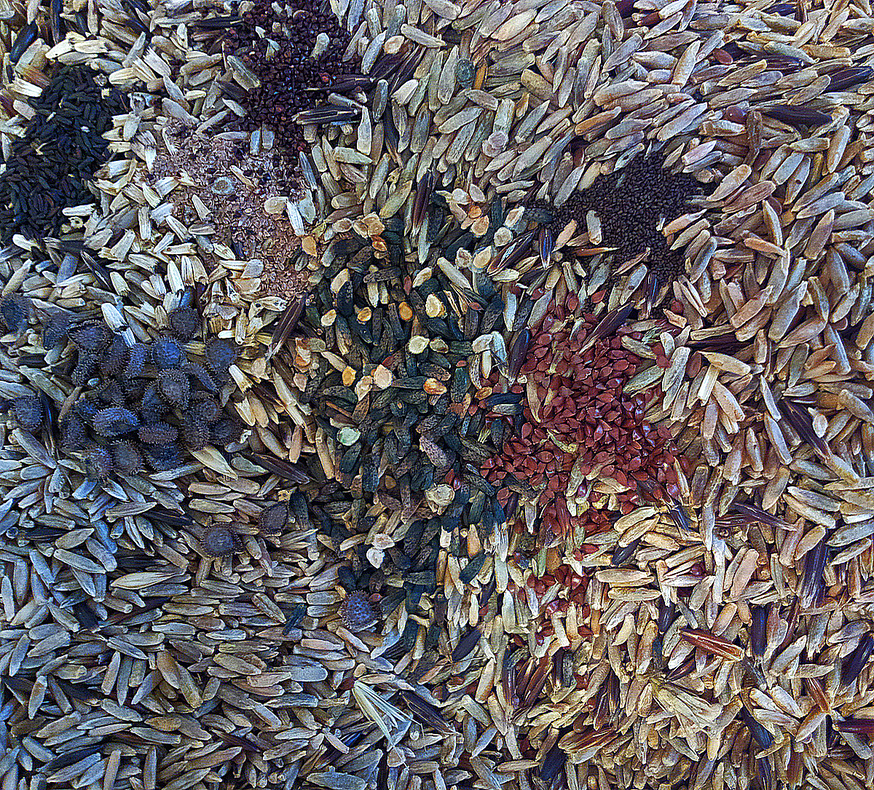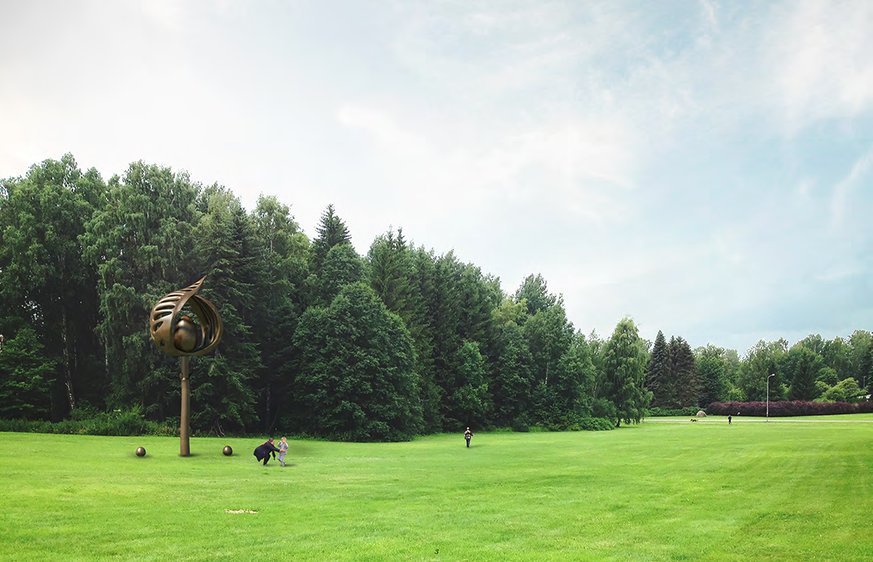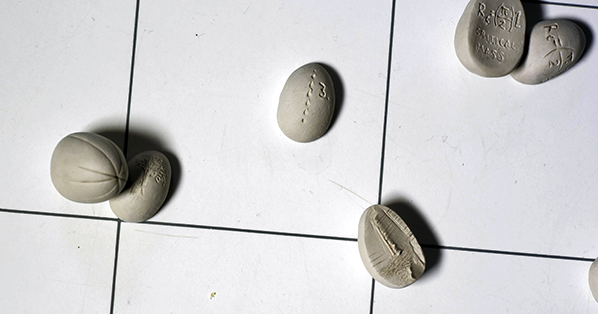1.2 Conservation as Monumental Action
After this intuition, theoretical and tangible elements started to collide: to preserve plant seeds inside a public monument seemed a conceptual novelty with exciting technical, philosophical and aesthetic challenges. In terms of aesthetics, I was attracted to classical volumes and to the texture of bronze, which from an anthropological perspective fits perfectly, bronze being the material that marks the age of implementation of large-scale agriculture in human history.[5] Curious of the relation between agriculture and power, I researched the shapes of ancient agricultural tools looking at artifacts conserved in the Museum of Prehistory in Florence and in Sarka Museum of Agriculture in Finland. The social rank credited to blacksmiths, who were simultaneously forging weapons and agricultural tools in the antiquity, speaks volumes of the allure that is given to bronze through its imperial status in fine arts. The birth of public art has its own history related to stone and bronze. The process of extracting, forging and polishing bronze, gives credibility to public art by representing eternal values. Just as well, many public and private investors are inclined to support an artwork and to collect it when the materials used are consolidated with such level of agency and durability.
Set on the trail of the representation of power in public art, which in my research appeared in a peculiar overlapping of agriculture, botany and sculpture, I validated the appearance of the sculpture with a classical form. It seemed an appropriate vocabulary for the targeted audience: mainly baby boomers, in particular those in positions of power and decision-makers, who made no effort to implement into society the knowledge provided by the numerous scientific scholars, warning about the global environmental collapse.[6] We need to situate those thoughts regarding the need of dialogue with the publics of the work, including the political class, in 2008, the year that saw the first global economic crisis of the twenty first century, giving rise to the propagation of austerity politics, as fast as a new kind of political pandemic. While a consolidated neoliberal apparatus had progressively dismantled workers rights, compromised access to good public health care and to higher education, and had damaged the environment with an aggressive extractive economy, it appeared already how unsolved imbalances outlined in the public domain, had compromised the democratic access to common good. Consequently, the esthetic of the bronze sculpture was conceived as a Trojan horse: the aim was to promote the principle of transparent and collective management of natural resources through a quiet classical shape that easily meets the eye.
In the same years the work of Slow Food International and of Vandana Shiva, the world-renowned controversial scholar and environmental activist, started to pick up on public attention again, while supporting conservation of vegetal biodiversity since the 1980's.
I started to study the role of seeds in international economic transactions and their weight in the management of agricultural resources in Europe, as well as in countries from which I could find disaggregated data available. I conducted this study as an autodidact, and I became aware of the large impact of vegetal biodiversity on economic and geopolitical reality. Following only official sources, such as The European Parliament, Directorate General for Internal Policies, I learnt that the European seed market is the third largest in the world. France, Germany and Italy provide roughly half of the seeds sold in the EU. European producers are distinguished from other areas in the world for their strong diversification in size, product portfolio, and geographic areas covered. Small and medium enterprises represent the strength of the seed sector in Europe. In 2008-2009 the processes of market concentration were still relatively slow in Europe in comparison with other areas such as the US, where the production process is entrusted to a few large firms with strong international vocation. In 2008-2015 the seed market value in Europe was estimated to be around 7 billion euros and represented about 20% of the global turnover. It was the third in the world after the United States (27%) and China (22%), far exceeding Brazil, covering only 6% of global movements. The seed market is booming. Between 2005 and 2012 its growth was +45%, in line with the global trend of expansion that in the same period showed a +76%.
Looking at the economic impact of biodiversity,[7] observing the emerging regulations for consumers' rights,[8] the limitations imposed on circulation of certain seeds due to their productivity,[9] and the first legitimate scientific doubts about genetically modified food,[10] the form of my thoughts changed. The decision to place plant seeds inside the sculpture completely realigned my priorities, and enriched my understanding of what public art is in the twenty-first century, what art can do, and who is the public.
First of all, what kind of seeds could I include inside the public monument? Differently from their use in industrial agriculture, the identity of seeds and plants is not separated from their habitat; in this sense seeds embody the potential of each biocenosis [11] and its biotope.[12] Each individual plant seed, besides representing a set of characters homogeneous in a variety, presents a certain degree of plasticity connected with the conditions in which might or might not grow. This type of autonomy associated with choice is a given when considering humans and their behaviour, but it seems it has never been consistently addressed with its multiform potential in plants, to which we rarely attribute individuality beyond the variety they belong to. Population biology is an exception to it, where the preservation of individual characters expressed in different dna samples are considered an important element to represent a population. Since the beginning of agriculture, the human fascination with plants has mainly driven towards the control of the characters, progressively abandoning the vernacular practices that were giving space to a polyphony of variations and hybrids. Seeds are able to move in time and space thanks to their quiescence, propagating the genome of different plants at their germination. The strategies developed by plants for the reproduction and distribution of their descendents are extraordinarily varied and complex. Humans tend to look at seeds and plants from certain points of view: their botanical classification, benefit for human controlled habitat, economic impact, nutritive characteristics, aesthetic qualities, and potential of becoming a product.
Around 2007-2009 a considerable debate was building up around the precautionary principle applied to GM organisms. During the same period, the NordGen[13] bank was established. I started reading available materials describing the function of seed banks, how collections are constituted, and how they relate themselves with society. The mission of institutional banks focuses on making germplasm available for scientific research or for the survival of humans in case of a planetary crisis. What struck me then, was the fact that many seed banks were completely uninterested in trans-disciplinary social interaction, although only recently many institutions have become keen to entertain public relations.
The function of the sculpture-action-container became more defined: an ark protecting vegetal biodiversity, a vehicle carrying seeds close to people during participatory public activities. I wanted it to enhance the classical function of seeds banks extending it into the social by providing the public something that seed banks can not give out to people: seeds. At that time, it seemed an adequate response to the austerity politics restricting access to welfare, and to the debate on national and international measures restricting access to commons and natural resources. The Ark of Seeds was born.
After I decided that I would solely preserve natural seeds, leaving out all types of materials subject one way or another to intellectual property or industrial copyright, I experienced a great relief. Looking at the controversies around who has the right to own natural seeds, I was reading on the various seed registration systems. It seemed apparent that the right to ownership over seeds is a thorny topic, because by excluding direct cultivators, native populations and first people who have been breeding seeds for centuries, it is sanctioned as a colonialist and unethical designation of nature. By consequence I felt the need to take distance from the mainstream assumption that a public artwork is unique and elitist, and I published the whole work under Creative Commons 4.0 Attribution International License. A proliferative approach against a restrictive one. I left the work open purposefully, hoping that anybody would re-use it, copy it, or bring it forward in different forms. Along the years, this has happened consistently.
From a capitalist logic, the success of accumulation strategy is associated with the removal of common resources from the public domain and participation. It is the opposite of lifelong learning, which provides tools for the collective care of common resources and shared benefits. As much as it is justifiable to patent a plant that is the result of an expensive industrial process, this does not apply to natural wild varieties, or local varieties of cultivars that have been gradually selected by generations of cultivators over the centuries. Once the seed is removed from the public domain, it will never return there. Its future becomes opaque and dependent on the human ownership. What a monumental function for a public artwork to preserve not only the seeds, but also preserving the rights of people to participate directly in the conservation process!
Was I moving from a sculpture-action into sculpting an activist? I have far too much respect for activists who dedicate themselves entirely to a cause and face actual risks, to use the term lightly. As an artist, my interests often collide with the political and the social. I find my role is closer to a storyteller and an instigator of change from a cultural perspective. Shifting the function of a public monument from the representation of power into that of a social change-maker could probably be included in the milieu of the educational turn, the curatorial direction pretending to justify the function of art and curatorship through an educational purpose. But even so, between 2007 and 2013 there were no curators that would have been directly mingling with the process. Sense-making was scattered in all directions, thus leaving the work wide open.
Numbers Are, detail of work presented at Casablanca Biennial of Contemporary Art. A series of clay pieces scattered on a grid simulate the seemingly unrelated presence of environmental activists on the world map. The work became a line of jewels called Critical Mass. Each jewel functions as music instrument and seeds' container.


